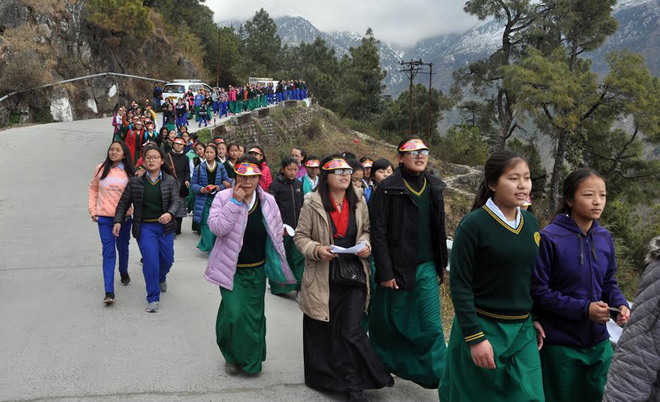
It’s a long way home: Women take out a rally to mark the Tibetan Women’s Uprising Day in Dharamsala file photo
Shelly Bhoil
This Earth Dog year, the exiled Tibetans observe the 59th anniversary of the Tibetan National Uprising that had taken place in Lhasa on March 10. The world over, the day is commemorated through protests, mainly outside the Chinese embassies, shouting anti-Chinese slogans, unfurling the snow lion flag and Free Tibet banners, getting lathi-charged and jailed — everything that amplifies their Tibetan identity and right to self-determination.
Surprisingly, most of these freedom activists are youngsters who have never been to Tibet. What drives the political orientation of the second- and third-generation Tibetans-in-exile is the fact that they are born to refugee parents and inherit but a ruptured history. Nyima Nanchung, a third generation Tibetan-in-exile who works for the Central Tibetan Administration, is vocal, “We do not have the luxury of being an independent nation, and therefore, we are born with the responsibility to work for our cause. I am proud to be a Tibetan because that gives me a purpose in life, and the fact that I am a woman means that I have an inherent capacity to make a difference.”
Being born as refugees also means that Tibetans are in a complicated relationship with their host country. Though Tibetans in India can gain state citizenship under Indian Citizenship Act of 1955, the rigor of bureaucratic process is discouraging. Lobsang Wangyal, born in the Tibetan settlement of Orissa in 1970, had to fight two legal battles in Delhi High Court to attain his Indian passport. “Our sense of belongingness has broadened over the years. We may be prompted to seek citizenship of host countries because of our practical needs of survival such as the lack of employment opportunities for refugees, however, our allegiance remains to our exiled government in Dharamsala,” says Tsering Gyalpo, a student at Jawaharlal Nehru University.
Several Tibetans introduce themselves as Tibetan-Indians to outsiders because of their sense of ‘filiation’ with their ancestral homeland, Tibet, and ‘affiliation’ with India where they have been born and bred. What then explains the tensions that brew between Indians and Tibetans across Tibetan settlements? A Tibetan youth from the Clement Town in Dehradun, worried about the recent scuffle that took place in Sataun village of Sirmaur district, vents, “Our leaders hobnob with Indian ministers but forget to work on our relationship with common Indians with whom we interact on a daily basis!” A third-generation youth, who grew up in Dharamsala, says Tibetans in India broadly live a secluded life. “Our interaction with India is limited to Nalanda and Bollywood, or it is necessity-based with taxi drivers, storekeepers, traffic police, bus conductors, and the like. We have little understanding of our Indian counterparts.”
At the root of this limited interaction has been the precarious situation of Tibetans — an urgent need to preserve their culture that is being sinicised under Chinese occupation — which makes them adopt a policy of strategic assimilation. Indians, by and large, seem to lack an understanding of Tibetans’ peculiar circumstance because of which the two enter into altercations unawares. “While we can visit their temples, shops, restaurants and even hospitals, it’s very hard to have access of the Tibetan community. They are very selective about their engagement with the locals,” a doctor from Kangra says.
For young Tibetans, the challenges are various. Not only do they deal with the indignation of Indians but also the conflicts of political goals among their leaders. The chasm of ideology between the rangzen or freedom activists of Tibet and the supporters of what is called the exile establishment’s Middle Way Approach of seeking ‘genuine autonomy’ within the Chinese state, brings disenchantment among the present youth. A Tibet-born exiled youth in New York expresses, “If there is one challenge before Tibetan youth today, it is what exactly are we are fighting for — a piece of land, religion, culture, racial entity, what else!” He is resentful of the extreme religiosity of the Tibetan government, which, he says, “has replaced the hardcore issue with a sentimental one.”
Given the challenges of belonging, leadership and China’s hardline policy on Tibet, the road ahead is trying for the Tibetan youth. But their resolve to be rooted in their identity, despite three generations in exile, is where they invest hope as they commemorate another anniversary of the Tibetan National Uprising.



























